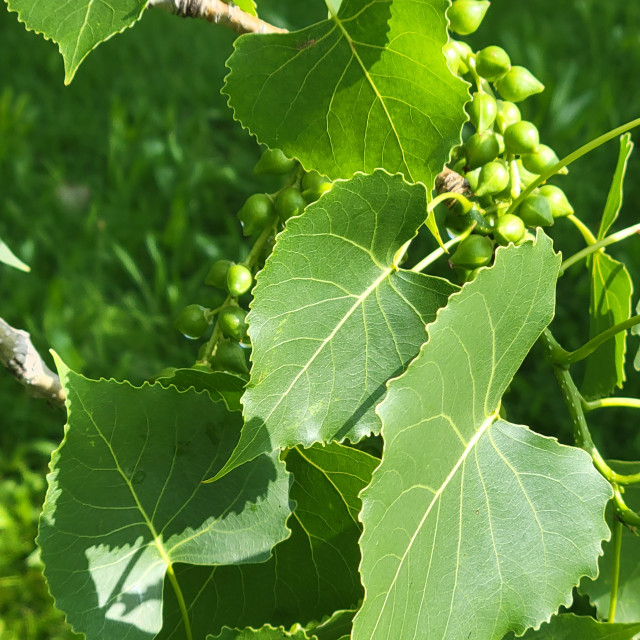COMMON NAME
Eastern cottonwood
SCIENTIFIC NAME
Populus deltoides
ALSO KNOWN AS
Necklace Poplar, Carolina Poplar, Alamo, Common cottonwood
Plant family
Willow (Salicaceae)
Plant group
Deciduous Trees and Shrubs
A fast-growing poplar that can grow over 75 feet tall. It produces racemes of cottony seeds in the spring that are released into the air and may clump up on the ground, making it look white. This tree has triangular shaped leaves, which is where the "deltoid" in the species name comes from. The leaves have coarse teeth along their edges.
514 reports
147+
OBSERVERS
514+
OBSERVATIONS
Identification hints
Eastern cottonwood is a large deciduous tree that has a dark gray and cracked bark when mature. Leaves have an alternate arrangement with 2-5 inch long, coarsely-toothed, papery, and triangle-shaped leaves that turn yellow or brown in the fall. Eastern cottonwoods are dioecious; male trees have dangling reddish catkins before leaves appear (in late March/early April), whereas female trees have yellow flowers. Fruit appears in May and June on female trees, and is a dangling cluster of capsules that release fluffy seeds that can fly on the wind.
Did you know?
It is one of the fasted growing native trees, and can average 5 feet (1.5 m) of annual height growth in favorable conditions.
DISTRIBUTION IN TH U.S.
Alabama
,
Arkansas
,
Arizona
,
Colorado
,
Connecticut
,
District of Columbia
,
Delaware
,
Florida
,
Georgia
,
Iowa
,
Illinois
,
Indiana
,
Kansas
,
Kentucky
,
Louisiana
,
Massachusetts
,
Maryland
,
Maine
,
Michigan
,
Minnesota
,
Missouri
,
Mississippi
,
Montana
,
North Dakota
,
Nebraska
,
New Hampshire
,
New Jersey
,
New Mexico
,
New York
,
Ohio
,
Oklahoma
,
Pennsylvania
,
Rhode Island
,
South Carolina
,
South Dakota
,
Tennessee
,
Texas
,
Utah
,
Virginia
,
Vermont
,
Wisconsin
,
West Virginia
,
Wyoming
HABITAT
Widely distributed in Great Plains states eastward throughout the Midwestern and eastern US especially in riparian areas. It grows best on moist well-drained sands or silts near streams, irrigation ditches, riverbanks, and roadsides.
ATTRIBUTES
Leaves
The leaves are simple and alternate along a branch. The ‘deltoides’ part of the scientific name refers to the triangular-shaped leaves. They are 3 to 6 in (8 to 15 cm) long and are narrow and commonly long-pointed with fine to coarse rounded teeth. They have a very distinct odor when crushed, turning yellow in autumn. The petioles (the stalk that attaches the leaf to the plant) are very short and flattened and have a pair of small glands at the tip.
Flowers
Blooms in late March to early April. Male trees have dangling reddish catkins. Female trees have yellow flowers. The many tiny yellowish or greenish flowers usually appear in early spring before the leaves. The trees are dioecious which means the male (staminate) and female (pistillate) flowers are found on separate trees. Flowers are found in hanging catkins (long, drooping structures). The flowers appear in April or May before the leaves develop.
Fruits
The fruits are capsules with 3 or 4 valves about 0.25 in (0.64 cm) long. It is the fluffy, white, ‘cotton’ like seeds produced by the females in early summer that give the tree its name. The numerous tiny seeds are widely dispersed by the wind. The dangling cluster of dehiscent capsules mature in summer (on female trees only).
Bark
The bark is gray or brown and smooth on younger trees, becoming rough, scaly or furrowed with age. The slender twigs are yellowish-brown and are flexible to the touch, often shedding or easily detached at forks.
Bloom Time
Late March to early April
See Menu
- 2021 Chicago Botanic Garden. All Rights Reserved.
-
Creative Commons
BY-NC-SA 4.0 - Terms of Use
- Privacy Policy
- Data Sharing and Citation Policies
- 2021 Chicago Botanic Garden. All Rights Reserved.



